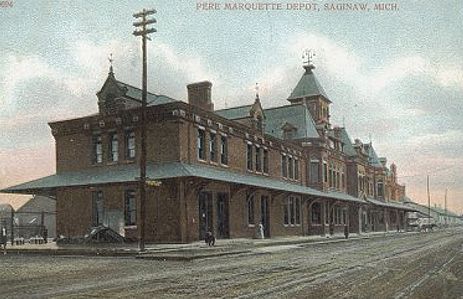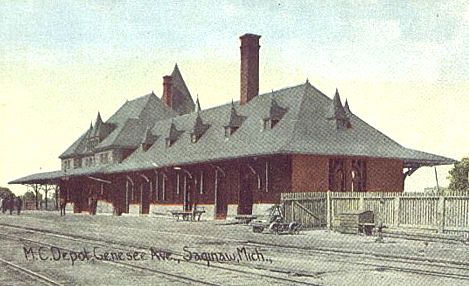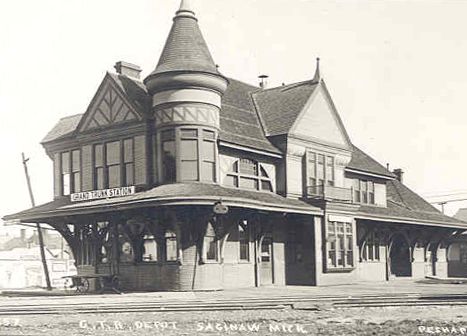- Details
- Hits: 52
Story: Saginaw: Leading Railway Center of State (1910)
From the Saginaw News, October 18, 1910
Ten Railroad Lines Give City Superior Transportation Facilities
Leading Railway Center of State
Numerous Divisions of Three Large Systems Radiate in all Directions
Terminal of Pere Marquette
This Company With Its Great Shops and Large Operating Force Employs Nearly 2,000 Men in the City of Saginaw
Sixty passenger trains arrive at and depart from Saginaw daily over the three trunk line railroads that with their branches radiate in every direction from the city like the spokes of a wheel from the hub. To every corner of the state these railroads annually carry hundreds of thousands of passengers and countless tons of freight, and they bring to the city thousands of persons bent on pleasure or business and also the vast quantity of merchandise provisions and other goods for the use of a busy and progressive community of over 50,000 inhabitants. For years Saginaw has been noted for its exceptional railroad facilities, and it is the constant aim of the railroad officials to better the service and in every way to care for the vast amount of business that originates here, both in the passenger and freight departments. The three distinct systems that form Saginaw's railway interests give the city railroad connections into a territory greater than that enjoyed by any city in the state outside of Detroit.
These three systems are:
- Pere Marquette - Detroit division, Ludington division, Port Huron division, Bad Axe divisions, Bay City division and Grand Rapids-Chicago division.
- Michigan Central - Detroit division, Jackson division, Mackinaw division
- Grand Trunk - Durand division
In addition to these, the Detroit & Mackinac road, skirting the western shore of Lake Huron and reaching to Alpena and Cheboygan, gives the city direct and easy connection with those two enterprising cities and the numerous towns that dot the lake shore.
These roads bring New York city within 21 hours of Saginaw; Chicago within 10 and Detroit within 2½ hours.
These facilities make Saginaw an important railroad center. All three trunk lines reach Chicago almost directly, through cars being run to the metropolis over the MC and GT, while the PM gives train service through to the big city on the western shore of Lake Michigan. With sixty passenger trains entering and departing from the city every week day, with good service each Sunday, the traveler is enabled to quickly reach his destination any day and within reasonable time. Belt lines around the city and large and numerous railroad yards give the shipper unusual facilities for handling of freight with rapidity and ease.
 The main passenger station of the PM is on Potter street, where much of the business of the system is handled, and there is also a pretty and commodious station on the west side of the river at the Court Street crossing, with another at Mershon for the accommodation of residents of the northwestern section of the city and the suburbs of Carrollton and Zilwaukee.
The main passenger station of the PM is on Potter street, where much of the business of the system is handled, and there is also a pretty and commodious station on the west side of the river at the Court Street crossing, with another at Mershon for the accommodation of residents of the northwestern section of the city and the suburbs of Carrollton and Zilwaukee.
The Michigan Central has a fine passenger station on West Genesee avenue, and a new building at Adams street, with a branch station on South Washington avenue on the east side. The main station of the Grand Trunk is on South Washington avenue, with a small station on West Genesee avenue. The freight houses are conveniently located to take care of all the shipping on both sides of the river.
An army of men is employed in various capacities by the three railroads, the majority of them making homes in Saginaw. The Pere Marquette alone employs 2,000 men, of which number about 400 are employed in the extensive shops here, and the balance in the operating department. The railroad disburses over $1 million in wages every year to its local employees, and the majority of them spend this money directly with home merchants. The Michigan Central and Grand Trunk also employ a large number of men, but the fact that the PM has its shops here places it far in the majority in the number of employees.
A Saginaw Institution
The PM railroad is essentially a Saginaw institution. It is the successor of the old Flint & Pere Marquette railroad and the foundation for which was laid in January, 1857, when the company was organized. No extensive work was done on the road, however, until 1859 when Samuel Farwell and his son-in-law, Dr. Henry C. Potter of Utica, NY, as constructing firm, took the contract from the organized company to build the road. The firm had done considerable work when the men who controlled the road failed, owing the constructing company considerable money, as well as a large amount to E.B. Ward, president of the Wyandotte Roller Mills, for rails. Seeing that the road was at a standstill, Messrs. Farwell & Potter and Captain Ward, each of whom had considerable amount of stock in lieu of their accounts, organized a new company with E.B. Ward as president, Samuel Farwell, vice-president and H.C. Potter, secretary and treasurer and general manager.
When all legal complications had been adjusted, the work of construction was begun southward, the first rail being laid on the dock near the old F&PM railroad bridge, August 11, 1859. The terms of the land grant provided that certain acreage was to be turned over to the road on the acceptance by the governor of the state of every twenty mile section of railroad, and the first twenty miles was accepted by Governor Wisner on September 5, 1860.
After the panic of 1857 the finances of the country were severely disturbed until 1862 and 1863 when the government began its great expenditures growing out of the civil war. Inducements for building a railroad from Flint to Saginaw were fairly good, but from the Saginaw river to Ludington on Lake Michigan, a distance of 139 miles, there were but two settlements. Midland, with 500 population and Hersey with 200. The whole line was through a dense wilderness. The land grant awarded to the company was largely pine lumber, but pine timber in those years was not in demand and constituted no temptation for the construction of a railroad, and the work of raising money for the work was very difficult.
The road was opened as far as Morris January 20, 1862 by an excursion participated in by many citizens, but the equipment was made up of the engine, one baggage car and one coach, being the entire passenger equipment of the road. The road was pushed on to Flint the following December.
About this time Flint parties had succeeded in constructing a road from Holly to Flint, finishing it in 1864. The F&PM company saw the advantage of having that road in connection with its own. Finally a deal was made which resulted in the purchase of the Holly line, and by connecting with the Detroit & Milwaukee at Holly, a road to Detroit was secured. This purchase was made in 1868.
The attention of these pioneers in giving Saginaw a railway was not entirely southward. The big land grant by congress, of which they wished to take advantage, called for a road to the west and north of here, and in 1867 the road from Saginaw to Midland was finished, and the same year the line from Saginaw to Bay City. The road opened from Midland to Averill was opened December 1, 1868, from Averill to Clare November, 1870, and by 1874 the entire line was finished to Ludington, and a little later the Manistee line was completed.
About the time of the completion of the F&PM to Ludington, the Holly, Wayne & Monroe road was under construction, and after its completion a rivalry sprang up between the F&PM and the Michigan Central as to who should control it; but the former won, giving it a line by way of Wayne to Detroit and by way of Monroe to Toledo. In later years it secured entrance and its own terminals in each city.
When the road was compelled to go in the hands of a receiver in 1879, owing to the struggles it had undergone after the panic of 1873, Jesse Hoyt came to the rescue with his private fortune, having been elected president in 1875, and largely through his efforts the road was rebuilt with new steel rails and had new equipment.
A few years ago the road passed into the control of the Cincinnati, Hamilton & Dayton railway, but the change was not beneficial, and after passing through receiver's hands it reverted to its present owners and has since been gradually returning to its former prosperous condition, its statement for the first fiscal year being very favorable and showing increased earnings in all departments, with rapidly growing business.
During the first 30 years of the company's existence, from January, 1861 to 1891, not an accident happened whereby a passenger was injured on one of its trains.
The Michigan Central
The management of the Michigan Central railroad nearly half a century ago foresaw the possibilities of the development of northern Michigan and late in the sixties the Detroit and Jackson branches of that road were completed to Saginaw, and they were followed almost immediately by the Mackinaw branch, extending to the straits. These three branches opened up an immense territory for the business and manufacturing interests of Saginaw, and with their connections have placed at the doors of this city a vast area of country to be served.
 In the Michigan Central's connections, like those of the PM and Grand Trunk, extend to every corner of the state and reach a vast population, a goodly share of the trade of the sections thus brought into contact with the outside world coming here. The Michigan Central has well equipped offices and roundhouses here and a number of its employees are residents of Saginaw, thus contributing materially to the commercial life of the third city. The road has recently spent considerable money in improvements to its grounds around the West Genesee avenue station while the fact that within the past year it has completed a fine station at the foot of Ames street to replace the station on Court is proof of the confidence the officials have in the city and its future.
In the Michigan Central's connections, like those of the PM and Grand Trunk, extend to every corner of the state and reach a vast population, a goodly share of the trade of the sections thus brought into contact with the outside world coming here. The Michigan Central has well equipped offices and roundhouses here and a number of its employees are residents of Saginaw, thus contributing materially to the commercial life of the third city. The road has recently spent considerable money in improvements to its grounds around the West Genesee avenue station while the fact that within the past year it has completed a fine station at the foot of Ames street to replace the station on Court is proof of the confidence the officials have in the city and its future.
The Washington avenue station was erected for the accommodation of the east side patrons of the road who did not care to travel several miles out of their way to reach the west side stations. Further improvements are under contemplation by the management, all of which will be to the decided advantage of Saginaw.
W.R. Burt Builds C.S.&M
To W.R. Burt is Saginaw indebted for the building of the Cincinnati, Saginaw & Mackinaw road, now under the control of the Grand Trunk. About 20 years ago, Mr. Burt undertook the construction of this line, extending from Durand on the south to Saginaw on the north, and thence running to Bay City. At Durand there were excellent connections with the Grand Trunk and Ann Arbor roads, opening up to the business interests of the city a field not reached by other roads, the one extending to the east and into Canada and the other reaching out to the west and northwest. Largely with his own capital, Mr. Burt completed the road and inaugurated a schedule of freight and passenger traffic and it was not long before the company was on substantial footing.
 The Grand Trunk officials had long contemplated an entrance to the valley and its rich freight business and they saw in the CS&M road the opportunity they sought, so they entered into negotiations with Mr. Burt for the purchase of the road. The result was that in a few months the management passed into the Grand Trunk, and the road is now operated as a part of that system, with its branches running to the Atlantic coast, and giving fine connections for both passenger and freight service.
The Grand Trunk officials had long contemplated an entrance to the valley and its rich freight business and they saw in the CS&M road the opportunity they sought, so they entered into negotiations with Mr. Burt for the purchase of the road. The result was that in a few months the management passed into the Grand Trunk, and the road is now operated as a part of that system, with its branches running to the Atlantic coast, and giving fine connections for both passenger and freight service.
Unsurpassed Service
Thus finely is Saginaw equipped for railroad service - service that as stated is not surpassed by any city in Michigan, save Detroit. Every part of the country is with easy access of this city. New York is only a matter of a journey of 21 hours, while Chicago is less than ten hours distant and Detroit is reached in two and one half hours. To nearby places it is only a matter of minutes now, when formerly it was hours. The roads that started their wheels turning in the olden days when time did not cut such an important figure as to at present have grown to vast proportions, the old rails have given place to steel bands that are practically one continuous link through the system., and the tiny engines of the early days of railroading have been replaced by ponderous affairs capable of drawing almost limitless loads. New passenger depots have replaced dingy structures improvements without number have been made and extensions of lines have brought additional territory within reach of the city and its business men and manufacturers. The railroads have played an important part in the prosperity and development of Saginaw, and that their service is recognized is attested by the business that is given. Sixty passenger trains running into and out of a city in a day is a proud boast of a place the size of Saginaw, and few there are in the country of equal population that enjoy such facilities.

"Moguls" On Railroads of the 19th and 20th Centuries
The growth and expansion of both business and facilities of the Pere Marquette railroad, Saginaw district, are well exemplified in the comparison of the types of locomotives which were in operation 15 years ago on the lines centering out of Saginaw and the giant "moguls" of today. When the railroad man talked of big types of locomotives along in the years of the nineteenth century he referred to the mogul type which was used to haul the freight over the lines of the road.
Time and Necessity Bring Changes
The engines were considered marvels of construction and of up-to-date builders' art. Time in this department of building has worked wonders, so has necessity. The engine of today which is almost twice as long and is capable of many times the drawing capacity is a real monarch of the rails.
The Pere Marquette railroad has ordered within the last six months 16 of the consolidated type, each costing approximately $20,000. That means $320,000 or thereabouts for the district of the road along and it is brought about by the fact that the system is carrying an immense amount of freight and the need of big power carriers is imperative.
In the days of 15 years ago big engines were not needed. Here is a comparison of the types of the old and the new which is symbolic of the comparative business of that time and the present:
No. 249 - cylinder 16x24 inch; wheel 44 inch with tire 50 inch; boiler flues 157 two-inch tubes, 10 feet 8 inches long; total weight of engine 140,000 pounds; tank capacity 2,450 gallons; tender capacity six tons of coal; steam pressure 140 pounds, drawing capacity 900 tons; length over all about 30 feet.
No. 605 - cylinder 22x30; driving wheel 54 inches, with tire 61 inches; steam pressure 200 pounds, boiler flues 340, two inches 16 feet long, length overall; 70 feet, weight 361,000 pounds; tank capacity 7,000 gallons; coal tender 14 tons, and drawing capacity 3,000 tons.
The Saginaw district embraces Saginaw division, Ludington, Toledo, Bay City, Port Huron and the Saginaw, Tuscola and Huron divisions.
Bibliography
The following sources are utilized in this website. [SOURCE-YEAR-MMDD-PG]:
- [AAB| = All Aboard!, by Willis Dunbar, Eerdmans Publishing, Grand Rapids ©1969.
- [AAN] = Alpena Argus newspaper.
- [AARQJ] = American Association of Railroads Quiz Jr. pamphlet. © 1956
- [AATHA] = Ann Arbor Railroad Technical and Historical Association newsletter "The Double A"
- [AB] = Information provided at Michigan History Conference from Andrew Bailey, Port Huron, MI

